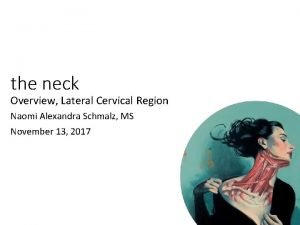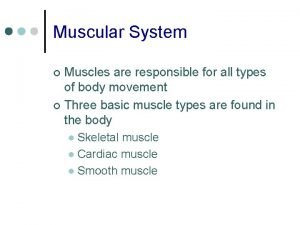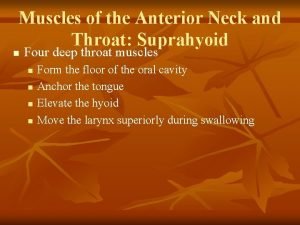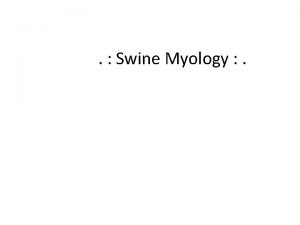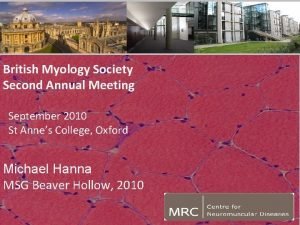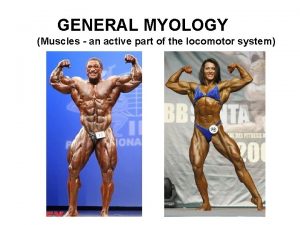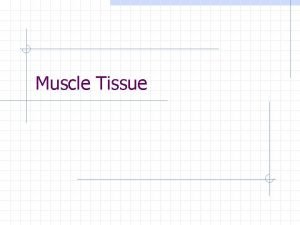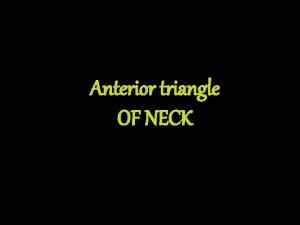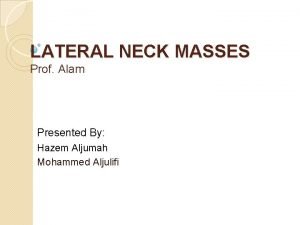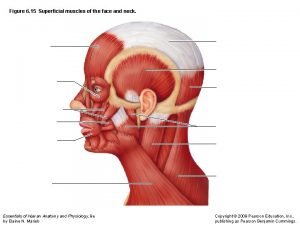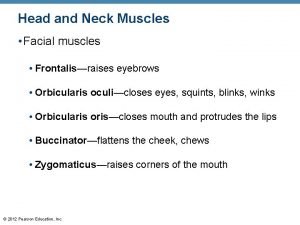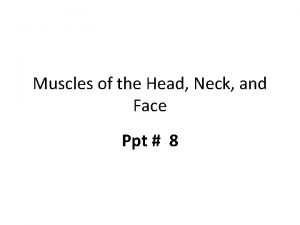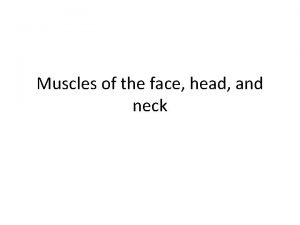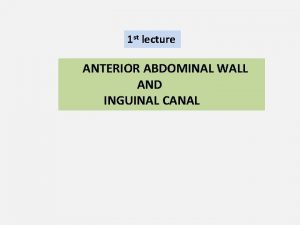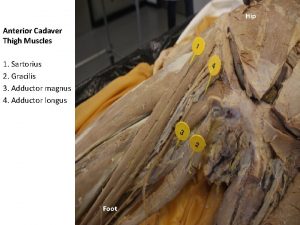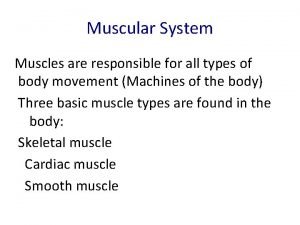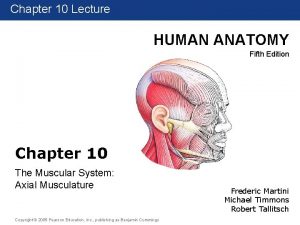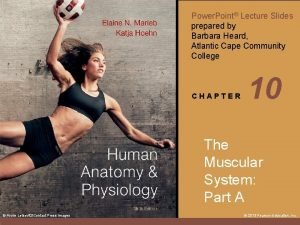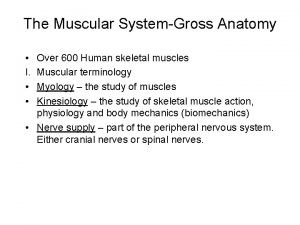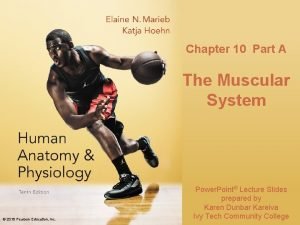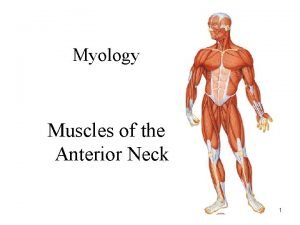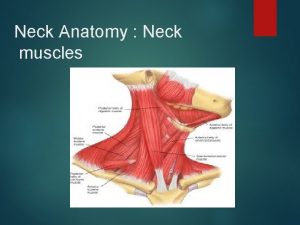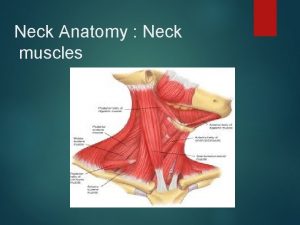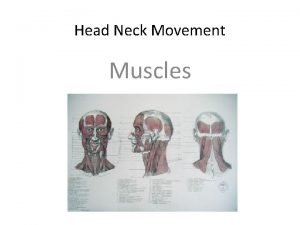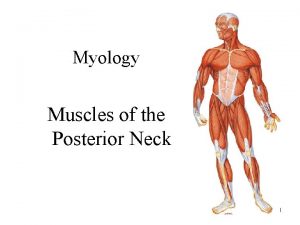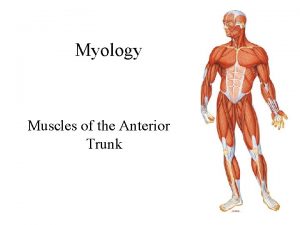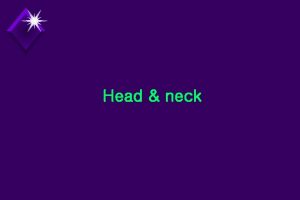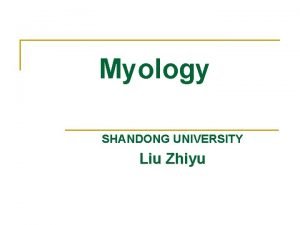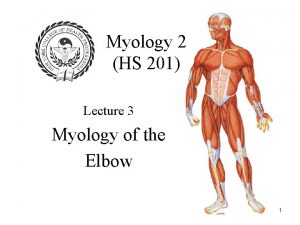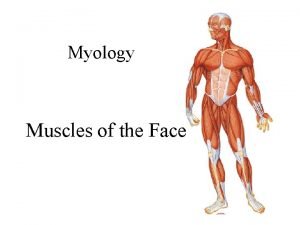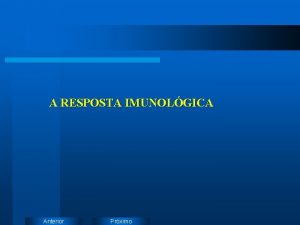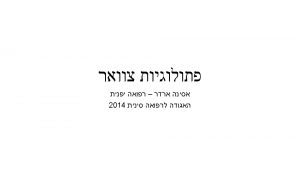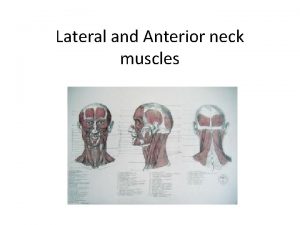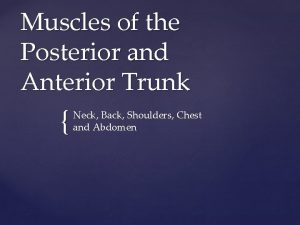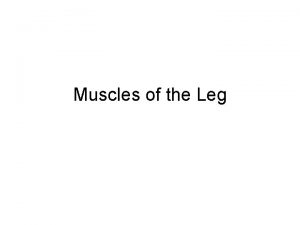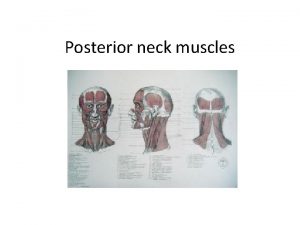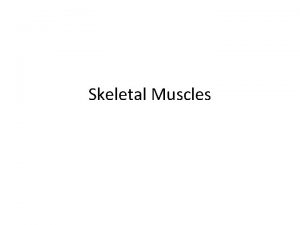Myology Muscles of the Anterior Neck 1 Muscles



























- Slides: 27

Myology Muscles of the Anterior Neck 1

Muscles of the Neck Overview • Muscle of neck are divided into two groups: – Anterior • Superficial (2) • Hyoids – Infrahyoids (4) – Suprahyoids (4) • Scalenes (3) • Deep (4) – Posterior • Superficial (4) • Deep (4) • Note: Some sources divide neck into anterior, posterior, & lateral. 2

Muscles of Neck Overview • Functionality – Since these muscles cross the joints of the cervical spine, they can move the neck at the cervical spinal joints – If a muscle also crosses the atlanto-occipital joint (C 0/C 1) then it can move the head upon the neck. 3

Muscles of Neck Overview • General Rules: – If a muscle crosses the neck posteriorly, it can extend the neck at the cervical spinal joints. – If a muscle crosses the neck anteriorly, it can flex the neck at the cervical spinal joints. – If a muscle crosses the neck laterally, it can laterally flex the neck at the cervical spinal joints. – If a muscle wraps around the neck, it can cause rotation of the neck at the cervical spinal joints. 4

Muscles of the Anterior Neck – Superficial (2) • Platysma : – By function it is primarily a muscle of facial expression i. e. innervated by CN VII. – Platysma of one side blends with contralateral side and other facial muscles in lower face. – Considered to by remnant of a broader muscle called panniculus carnosus found in four-legged animals. Enables horses to shake off flies and cats to raise hair on its back. – When contracted it is reminiscent of “Creature from the Black Lagoon” creature. • Sternocleidomastoid (SCM): – Since it attaches to sternum, SCM is considered an accessory muscle of respiration. 5

Platysma O: Subcutaneous Fascia of Superior Chest I: Mandible and subcutaneous fascia of lower face A: Draws up the skin of superior chest and neck, creating ridges in neck skin. Assists in drawing the lip laterally and depresses the mandible N: CN VII (Facial nerve) Palpation: Page 138 6

Sternocleidomastoid (SCM) O: Sternal Head: manubrium Clavicular Head: Medial clavicle I: Mastoid process Actions: Bilateral contraction: flexion of the neck. Unilateral contraction results in Lateral flexion of neck/head and Contralateral rotation of neck/head N: Spinal accessory nerve (CN XI) Palpation: Page 141 7

Muscles of the Anterior Neck – Infrahyoids (4) • All 4 infrahyoid muscles are located below the hyoid bone i. e. the pull hyoid bone inferiorly when contracted. • All hyoid muscle are important in moving and/or fixating the hyoid bone. These functions are necessary for chewing, swallowing, & speech. • Sternohyoid: – “Sterno” refers to sternum – “hyoid” refers to hyoid bone • Sternothyroid: – “thyroid” refers to thyroid cartilage • Thyrohyoid • Omohyoid: – “Omo” refers to the shoulder 8

Sternohyoid O: Posterior aspect of the manubrium and medial clavicle I: Inferior Hyoid A: Depression of hyoid N: Ansa cervicalis of the cervical plexus Palpation: page 147 9

Sternothyroid O: Posterior Sternum and 1 st costal cartilage I: Thyroid Cartilage A: Depression of thyroid cartilage N: Ansa cervicalis of the cervical plexus Palpation: page 150 10

Thyrohyoid O: Thyroid Cartilage I: Hyoid (inferior aspect) A: Depression of hyoid and Elevation of thyroid cartilage N: CN XII (Hypoglossal nerve) Palpation: page 152 11

Omohyoid O: Inferior Belly: Superior angle of the scapula Superior Belly: Clavicle via the central bound to the clavicle I: Inferior belly: Clavicle (via the central bound to the clavicle) Superior belly: hyoid A: Depression of hyoid N: Ansa cervicalis of the cervical plexus Palpation: page 155 12

Muscles of the Anterior Neck – Suprahyoids (4) • Digastric: – “Di” means two; “gastric” means belly – External carotid lies inferior and deep to anterior belly • Stylohyoid: – External carotid lies inferior and deep to stylohyoid • Mylohyoid: – “mill” refers to molar teeth • Geniohyoid: – “genio” refers to chin 13

Digastric O: Posterior belly: mastoid notch of temporal bone Anterior belly: Inner surface of the mandible I: Hyoid (via the central tendon) A: Elevation of hyoid, depression of the mandible, and retraction of the mandible. N: anterior belly: CN V (Trigeminal nerve) posterior belly CN VII (Facial nerve) Palpation: page 158 14

Stylohyoid O: Styloid process of temporal bone I: Hyoid Actions: Elevation of hyoid N: CN VII (Facial nerve) Palpation: page 161 15

Mylohyoid O: Entire inner surface of mandible (this muscle forms the muscular floor of the mouth) I: Hyoid A: Elevation of hyoid and depresses the mandible N: CN V (Trigeminal nerve) Palpation: page 164 16

Geniohyoid O: Inner surface of mandible, deep to the mylohyoid I: Hyoid A: Elevation of hyoid N: CN XII (Hypoglossal nerve) Palpation: page 167 17

Muscles of the Anterior Neck – Scalenes (3) • As a group, they attach superiorly from cervical TP's to inferiorly on the 1 st and 2 nd ribs • As a group, scalenes flex and laterally flex the neck • By reverse muscles action, the scalenes can elevated the 1 st & 2 nd rib i. e. they are also considered accessory muscle of respiration. 18

Anterior Scalene O: Anterior tubercles of the TP’s of C 3 – C 6 I: 1 st Rib A: Bilateral contraction: flexion of the neck. Unilateral contraction causes lateral flexion and contralateral rotation of the neck. Reversed muscle action causes Elevation of 1 st rib N: Ventral rami of the cervical spinal nerves Palpation: page 173 19

Middle Scalene O: Posterior tubercles of the TP’s of C 2 to C 7 I: 1 st Rib A: Bilateral contraction: flexion of the neck. Unilateral contraction causes lateral flexion of the neck. Reversed muscle action causes Elevation of 1 st rib N: Ventral rami of the cervical spinal nerves Palpation: page 176 20

Posterior Scalene O: Posterior tubercles of the TP’s of cervical spine I: 2 nd Rib A: Unilateral contraction causes lateral flexion of the neck. Reversed muscle action causes Elevation of 2 nd rib N: Ventral rami of the cervical spinal nerves Palpation: page 179 21

The Scalene Group • Scalenes, as well as SCM, are often injured during MVA called whiplash. • Also known as cervical acceleration deceleration (CAD) injury 22

Muscles of the Anterior Neck – Deep Prevertebral Group (4) • Called prevertebral muscles since they lie directly on the cervical spine vertebral bodies • Important at fixating (stabilizing) and neck/head while talking, swallowing, coughing, & sneezing • May also be injured during CAD • Longus Colli: – Has 3 parts: superior oblique, inferior oblique, & vertical – Considered to be a strong neck flexor • Longus Capitis • Rectus Capitis Anterior • Rectus Capitis Lateralis 23

Longus Colli O: Bodies of the C 3 -T 3 vertebrae I: TP’s and Bodies of the C 1 -C 6 vertebrae A: Bilateral contraction causes weak flexion of neck. Unilateral contraction causes lateral flexion and contralateral rotation of the neck. N: Ventral rami of the cervical spinal nerves For the purpose of HS 113, this muscle is not palpable 24

Longus Capitis O: TP’s of C 3 – C 5 I: Basilar portion of the occiput A: Bilateral contraction causes Flexion of head/neck. Unilateral contraction causes Lateral flexion of head/neck N: Ventral rami of the cervical spinal nerves For the purpose of HS 113, this muscle is not palpable 25

Rectus Capitis Anterior O: TP of the Atlas (C 1) I: Inferior surface of the basilar portion of the occiput A: Flexion of head N: Ventral rami of the cervical spinal nerves For the purpose of HS 113, this muscle is not palpable 26

Rectus Capitis Lateralis O: TP of the Atlas (C 1) I: Inferior surface of the Occiput A: Lateral flexion of head N: Ventral rami of the cervical spinal nerves For the purpose of HS 113, this muscle is not palpable 27
 Strap muscles of neck
Strap muscles of neck Pectoral girdle muscles
Pectoral girdle muscles Throat muscles labeled
Throat muscles labeled Muscles
Muscles British myology society
British myology society Facial muscles labeled
Facial muscles labeled Study of myology
Study of myology Spinocostal muscles
Spinocostal muscles Supersternal notch
Supersternal notch Profalam
Profalam Muscles of the anterior torso
Muscles of the anterior torso Neck muscles
Neck muscles Face detection ppt
Face detection ppt Head and neck muscles
Head and neck muscles Extensors of the leg
Extensors of the leg What is hesselbach's triangle
What is hesselbach's triangle Sartorius cadaver
Sartorius cadaver Anterior torso muscles
Anterior torso muscles Skeletal muscles anterior view
Skeletal muscles anterior view Superficial muscles anterior view
Superficial muscles anterior view Human muscles anterior
Human muscles anterior Focus figure 10.1 muscle action
Focus figure 10.1 muscle action Chụp tư thế worms-breton
Chụp tư thế worms-breton Thế nào là hệ số cao nhất
Thế nào là hệ số cao nhất ưu thế lai là gì
ưu thế lai là gì Hệ hô hấp
Hệ hô hấp Tư thế ngồi viết
Tư thế ngồi viết Cái miệng xinh xinh thế chỉ nói điều hay thôi
Cái miệng xinh xinh thế chỉ nói điều hay thôi
